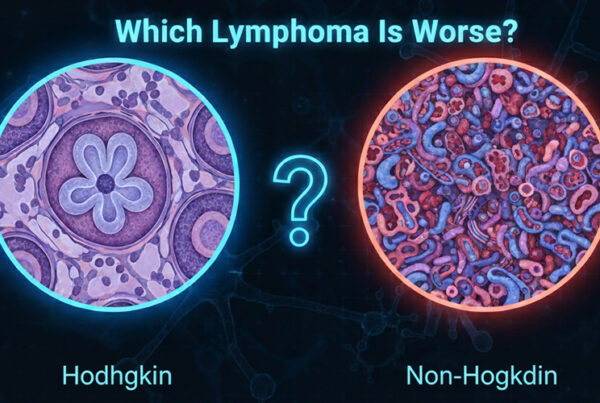
Key Takeaways:
- Lymphoma is diagnosed through a combination of physical exams, imaging scans, blood tests, and biopsies.
- Accurate diagnosis helps determine the specific type and stage of lymphoma, guiding personalized treatment.
- Ongoing research continues to improve how lymphoma is detected, classified, and monitored.
Introduction
Finding out that you might have lymphoma can be overwhelming. It is natural to wonder what happens next or how doctors confirm this type of blood cancer. Lymphoma begins in the lymphatic system, which helps the body fight infections. Because its early symptoms often resemble common illnesses, identifying it accurately requires several steps.
This blog explains how lymphoma is diagnosed, from the first clinical exam to laboratory and imaging tests. Understanding these steps can help patients and families feel informed and prepared when they begin the diagnostic process.
What is Blood Cancer?
Blood Cancer originates in the cells responsible for producing blood and managing the immune system. These cancers interfere with how the body makes and controls blood cells, particularly white blood cells, which defend against infection.
The main systems affected include:
- Bone marrow, where new blood cells are formed.
- The lymphatic system, which helps fight infections.
- The bloodstream, which carries cells throughout the body.
When cancer affects any of these, it disrupts the body’s ability to produce healthy cells and maintain immune balance.
Types of Blood Cancer
Blood cancers are generally categorized into three main types:
- Leukemia: Begins in the bone marrow and affects blood-forming tissues.
- Lymphoma: Starts in the lymphatic system and involves abnormal lymphocytes.
- Myeloma: Targets plasma cells that help the body produce antibodies.
Each type behaves differently, so diagnosis and treatment strategies vary.
Which Type of Blood Cancer is Most Dangerous?
Which Type of Blood Cancer is Most Dangerous? The aggressiveness of blood cancer depends on the subtype and stage. Acute leukemia is typically considered the fastest progressing. Certain high-grade lymphomas, such as Diffuse Large B-Cell Lymphoma, can also grow rapidly if left untreated. Early detection, monitoring, and research-based therapies greatly improve survival chances.
What Is Lymphoma?
Lymphoma is a type of blood cancer that begins in the lymphatic system. It affects lymphocytes, white blood cells that play a key role in immunity. When these cells grow uncontrollably, they can form tumors in lymph nodes, bone marrow, or other organs.
Lymphoma is a type of Lymphoproliferative Disorder, meaning abnormal growth occurs in lymphocytes. It mainly includes Hodgkin vs Non-Hodgkin Lymphoma, the two primary types that differ in cell characteristics and treatment approaches.
- Hodgkin Lymphoma (HL): Characterized by Reed-Sternberg cells.
- Non-Hodgkin Lymphoma (NHL): A broad group with many subtypes, including diffuse large B-cell and follicular lymphoma.
Early diagnosis gives patients the best chance for effective treatment. When lymphoma is identified early, therapy can target smaller areas and may require fewer treatment cycles.
What Are the Early Signs of Lymphoma?
Early symptoms of lymphoma are often subtle. Recognizing them promptly is critical for diagnosis.
Common signs include:
- Swollen lymph nodes in the neck, underarms, or groin that are usually painless.
- Fever and night sweats even when there’s no infection.
- Unexplained weight loss over a short period of time.
- Constant fatigue or a feeling of weakness that does not improve with rest.
- Itchy skin or rash without a clear cause.
Not everyone experiences all these symptoms. Some individuals discover lymphoma during scans or blood tests for unrelated reasons. Persistent symptoms warrant further evaluation.
How is Lymphoma Diagnosed?
What Initial Tests Help Detect Lymphoma?
The diagnostic process begins with a physical exam, where doctors check for swollen lymph nodes, an enlarged spleen, or tenderness in specific areas.
Next, several tests may be conducted:
- Blood tests (CBC) to detect abnormal cell counts or organ function issues.
- Imaging scans (CT, MRI, or PET) to detect enlarged lymph nodes or changes inside the body.
- Chest X-rays to look for swelling or masses in the chest area.
While these tests do not confirm lymphoma alone, they help determine whether a biopsy or additional testing is needed.
How Does a Lymphoma Biopsy Confirm the Diagnosis?
A biopsy remains the definitive diagnostic tool. A small tissue sample is removed from a lymph node or affected area and examined microscopically.
| Biopsy Type | Description | Purpose |
|---|---|---|
| Excisional Biopsy | Entire lymph node removed surgically | Provides complete tissue for detailed diagnosis |
| Incisional Biopsy | Part of a lymph node removed | Used when the node is large or deep |
| Needle Biopsy | Small tissue sample taken with a fine or core needle | Less invasive, often used for internal nodes |
A pathologist studies the sample to confirm the presence of lymphoma cells, identify the type, and observe their growth pattern. This information is crucial for treatment of decisions and research eligibility.
What Specialized Tests Help Classify the Type of Lymphoma?
Following a confirmed diagnosis, additional tests define the subtype and prognosis:
- Immunophenotyping (Flow Cytometry): Detects surface proteins on cancer cells to determine whether the lymphoma developed from B cells or T cells.
- Cytogenetic and Molecular Testing: Analyzes genetic mutations or chromosome changes that may affect disease progression and treatment response.
- Immunohistochemistry: Uses staining techniques to distinguish between Hodgkin and Non-Hodgkin lymphoma.
Conclusion
Diagnosing lymphoma involves multiple steps – initial symptoms, physical exams, biopsies, and molecular tests. Each step provides vital information for accurate classification and personalized treatment.
At NHO Revive, we advance Clinical Research Studies in Nebraska to improve outcomes for patients with blood cancer. Those diagnosed with lymphoma may have opportunities to participate in Follicular Lymphoma clinical trials or Diffuse Large B Cell Lymphoma clinical trials, gaining access to emerging therapies and contributing to research.
Staying informed and discussing clinical trial options with your healthcare team empowers you to take proactive steps in managing lymphoma.
Frequently Asked Questions
How Would I Know If I Had Lymphoma?
Signs include painless swollen lymph nodes, fatigue, night sweats, fever, and unexplained weight loss. Since these symptoms may overlap with other conditions, diagnosis relies on medical evaluation, imaging, and biopsy. Also Read
Which is Worse, Leukemia, or Lymphoma?
Both are serious. Leukemia begins in the bone marrow, affecting blood production, while lymphoma starts in the lymphatic system. Some aggressive lymphomas progress rapidly, but others respond well to treatment and grow slowly. Read more!
Which Type of Blood Cancer is Most Dangerous?
Lymphoma is generally not inherited. Having a relative with lymphoma slightly increases risk, but most cases result from random mutations in lymphocytes over a person’s lifetime. Environmental factors, immune disorders, and viral infections like Epstein-Barr virus may also contribute.
Is Lymphoma Genetic or Hereditary?
Lymphoma is not typically inherited. While having a close relative with lymphoma may slightly increase yes our risk, most cases develop due to random genetic mutations in lymphocytes during a person’s lifetime. Environmental factors, immune disorders, and viral infections like Epstein-Barr virus may also play a role. Read more!
What is the Difference Between Hodgkin vs Non-Hodgkin Lymphoma?
Hodgkin lymphoma features Reed-Sternberg cells, a unique cancer cell type. Non-Hodgkin lymphoma lacks these cells and includes various subtypes that differ in growth rate and treatment response. Hodgkin lymphoma is often highly treatable, even at advanced stages, whereas non-Hodgkin lymphoma requires subtype-specific approaches.







